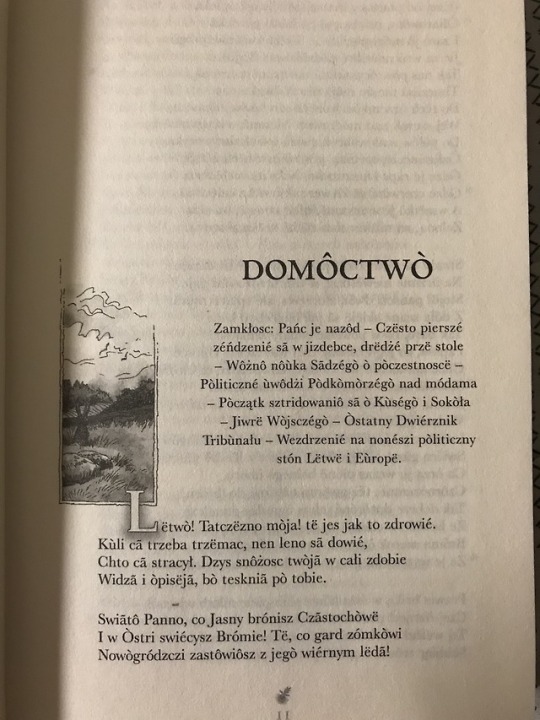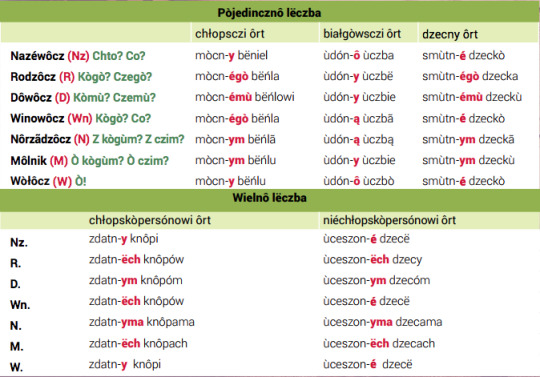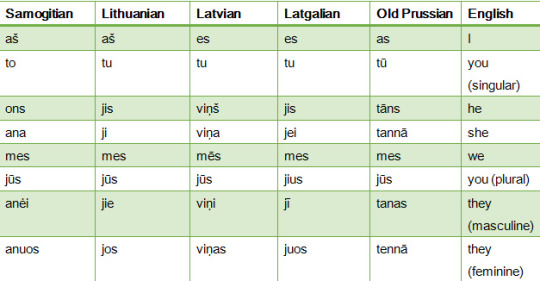Photo

Silesian boys in love. Traditional Silesian clothing and formal Silesian Miner uniform @cherrybeez_ for inspiration <3
653 notes
·
View notes
Text
Soooo... The Irish dub of Adventure Time premiered today...
+
4 notes
·
View notes
Text
Uhhhhh, anyone know enough about Polabian accentuation and vowel reduction to help me figure out some forms lmao
2 notes
·
View notes
Text
Potential Confusion
I wrote earlier that Kashubian, like Polish, marks the “object” of verbs like “bëc” with the instrumental in the absence of “to.” However, I have seen some example sentences in one of my dictionaries that use the nominative where I would expect to see the instrumental. If anyone knows any further details about why this may be, I would love to know, but for now keep in mind that I may have been mistaken in my earlier assertion.
UPDATE: So I’ve now seen both the sentence “Jô jem kaszëba” (”kaszëba” here in the nominative) and the sentence “Më jesmë kaszëbama” (with kaszëbama in the instrumental) in the same grammar so my best guess so far is that the use of the instrumental with verbs of identity is restricted to the plural. That may be wrong though, so if anyone knows any native speakers (the last native speaker in my family died in 2011), please let me know!
3 notes
·
View notes
Audio
Noges - Enez Rouz.
Off to Cardiff on a train in a sec, so i thought I’d upload this sweet, sweet Breton folk track, taken from a rare 1976 comp in support of a independent Brittany, Nothing but a metal harp and voice. Spooky Folky Dolky. I have no idea what the title means, but i guess Enez could be Island, and Rouz would be Red?, not sure..anyway… mwynhewch.
Tiwn oddiar casgliad prin o'r 70au yn galw am llydaw rhydd. mae'r casgliad hefyd hefo stwff gan Stivel arno fydd ai'n postio yn fuan. dwin cymryd mai Ynys Goch mae'r teitl yn feddwl, ond dwn im! bosib sa rhywun yn gallu gadale fi wybod. iawn, dwi off i ddal tren i'r ddinas mawr ddrwg. hwyl!
23 notes
·
View notes
Video
youtube
Niillas Holmberg & Roope Mäenpää - Giđđajoga baldu
29 notes
·
View notes
Photo

Northern Sami (davvisámegiella) is the most widely spoken Sami language. It is spoken by the indigenous Sami people in Finland, Norway, Sweden, and Russia. The number of Northern Sami speakers is estimated to be about 25,000. Northern Sami is a Uralic language and related to the Finnic languages (Finnish, Estonian, etc.).

Bures - Hello
Bures bures - Response to bures
Buorre iđit- Good morning
Buorre beaivi - Good day
Buorre idja - Good evening
Buorre eahket - Good night
Ipmel atti - Response to good morning, good day and good night
Oaidnaleapmái - Goodbye
Giitu - Thank you
Ándagassii - I’m sorry, excuse me
Juo - Yes
Ii - No

Listen: Merethe speaks Northern Sami
Learn about the Sami people:
Sámediggi
Saami Council
SIIDA
Learn Northern Sami:
Northern Sami resources
Northern Sami resources (mostly) for Finnish speakers
Resources for Sami languages (x)
257 notes
·
View notes
Photo


It finally came!!!
#langblr#kashubian#kaszubski#kaszëbsczi#pan tadeusz#pón tadeùsz#kashubian language#język kaszubski#kaszëbsczi jãzëk#językoznastwo
53 notes
·
View notes
Text
Òdmianë Znankòwników- Declension of Adjectives
Declining adjectives in Kashubian is much like declining adjectives in polish but with slightly different forms. Below are charts of the most basic declension patterns. The first pattern is used for adjectives whose roots end in letters other than s, c, k, or z. To find the root I recommend removing the final vowel from the singular nominative. Then in situations where “ii” would occur just simplify it to “i.” In this way stem alterations should make a little more sense.

The second pattern is used for those adjectives whose roots end in s, c, or z. Note that “i” has been replaced with “y.”

Not all authors will obey this alternation, so here are the forms without it.

Finally here are the forms for adjectives with roots ending in k. Note the alternation of “k” and “cz.”

Note the comma in the masculine singular accusative in some of the above charts. This is to indicate, as in Polish, that the masculine singular nominative form is used for inanimate masculine singular accusatives, and the masculine singular genitive is used for animate masculine singular accusatives.
#langblr#linguistics#kashubian#kaszubski#kaszëbsczi#kashubian language#język kaszubski#kaszëbsczi jãzëk#językoznastwo
20 notes
·
View notes
Text
Right now I’m waiting for my copy of Pón Tadeùsz (Kashubian Pan Tadeusz) to arrive, but when it does, let me know if you want some reading material in Kashubian and I can send you some pages.
#langblr#linguistics#kashubian#kaszubski#kaszëbsczi#kashubian language#kaszëbsczi jãzëk#język kaszubski#językoznastwo
7 notes
·
View notes
Text
14 cases of the estonian language are as follows:
1. Nimetav (Nominative)
leib (a bread)
2. Omastav (Genitive)
leiva (bread’s)
3. Osastav (Partitive)
leiba (the bread)
4. Sisseütlev (Illative)
leiba/leivasse (into bread)
5. Seesütlev (Inessive)
leivas (in bread)
6. Seestütlev (Elative)
leivast (from bread)
7. Alaleütlev (Allative)
leivale (onto bread)
8. Alalütlev (Adessive)
leival (on bread)
9. Alaltütlev (Ablative)
leivalt (off bread)
10. Saav (Translative)
leivaks ( [to turn] into bread)
11. Rajav (Terminative)
leivani (up to a bread)
12. Olev (Essive)
leivana (as a bread)
13. Ilmaütlev (Abessive)
leivata (without bread)
14. Kaasaütlev (Comitative)
leivaga (with bread)
1K notes
·
View notes
Video
youtube
Finno-Ugric languages - The magic of the north
Finno-Ugric languages become extinct. The world is losing its history, diversity of cultures and traditions. Only Finnish, Estonian and Hungarian are safe from the threat of extinction.
Music list:
1. Livonian - Sadā, Vīmo
2. Estonian - Greip - Vihma Loits
3. Ingrian - Ижорская народная песня фолк группа
4. Veps - Noid-Voik
5. Karelian - Santtu Karhu & Talvisovat - Čibi-čibi linduine
6. Finnish - MeNaiset - Kuulin äänen
7. Sami - Máddji - “Dawn Light”
8. Komi - Коми песня ‘Сьылан’
9. Udmurt - УДМУРСКАЯ ПЕСНЯ ФИННО-УГРЫ
10. Erzya - Мария Попова - Эрзянь мастор
11. Moksha - Куданьконь Кияксова - Moksha folk song
12. Mari - Кристина Лебедева и образц. детский ансамбль 'Шонанпыл’ - Шошо
13. Khanty - Хантыйская народная песня
14. Mansi - Тресколье - Кукушка
15. Hungarian - 'Szivárvány havasán’ - Guessous Majda Mária
1K notes
·
View notes
Photo

Comparison of pronouns in Baltic languages (with English translation)
323 notes
·
View notes
Video
youtube
Samogitian language in modern music
47 notes
·
View notes
Text
Just a heads up that my original post on personal pronouns originally had the charts for possessive pronouns, so if you want accurate charts you should see the new edited version.
#langblr#linguistics#kashubian#kaszubski#kaszëbsczi#kashubian language#język kaszubski#kaszëbsczi jãzëk#językoznastwo
1 note
·
View note
Text
Dosebné Zamiona- Possessive Pronouns
Possessive pronouns in Kashubian behave like adjectives in the first and second persons, and like genitive nouns in the third person. That is to say, that first and second person possessive pronouns agree with the nouns they modify in terms of number, gender, and case, whereas third person possessive pronouns do not change to agree with the nouns they modify, only to agree with the gender of the person to whom they refer. The exception to this is “swój,” which declines like a first/second person possessive, and means something like “my/ your/ his/ etc. own.” Below is the declension of the first, second, and “swój” pronouns, followed by the third person pronouns.


That may look like a lot of forms, but just remember that for the most part “mój,” “twój,” and “swój” have identical endings. The third person possessive pronouns are as follows:
His- Jegò
Her- Ji
It’s- Jegò
Their- Jich
And there you have it, that’s all you need to know to use possessive pronouns to your heart’s desire!
#langblr#linguistics#kashubian#kaszubski#kaszëbsczi#kashubian language#język kaszubski#kaszëbsczi jãzëk#językoznastwo
4 notes
·
View notes
Text
Kaszëbsczé Słowôrze- Kashubian Dictionaries
There’s not much out there in the way of Kashubian dictionaries, but there are a few I really like. Below are links to them.
1. https://drive.google.com/a/umass.edu/file/d/1XeSsOIGKslislarAwzRLdG6OmYAnqxNb/view?usp=drive_web
A really great beginner’s dictionary! Not terribly comprehensive, but a great introduction to the basics, and beautifully illustrated.
2. https://drive.google.com/file/d/1Tz99wxddqF1alnDjQRhDw5HIaRmWCRbD/view
Similar to the above, more of a textbook than a dictionary, but good for beginners!
3. https://drive.google.com/file/d/1lfejHcZ9DVRWOo_iEWvSTcci1BvbgsBR/view
Okay so this one’s excellent... there’s one problem... thanks to a hacker, only A-M is available. Still very useful all the same!
4. https://drive.google.com/file/d/1q6uxp8qGcT4gQP9QTKb-Swr3frpX-zzr/view
A really comprehensive dictionary, but only Kashubian to Kashubian, so a bit inaccessible to the beginner.
5. https://drive.google.com/file/d/1FSOj_o8LeVnZOuP-lxXzNxEPUnetExmC/view
Okay so this one is straight up just a textbook, but it’s great, so I’ll include it here anyway!
#langblr#linguistics#kashubian#kaszubski#kaszëbsczi#kashubian language#język kaszubski#kaszëbsczi jãzëk#językoznastwo
10 notes
·
View notes